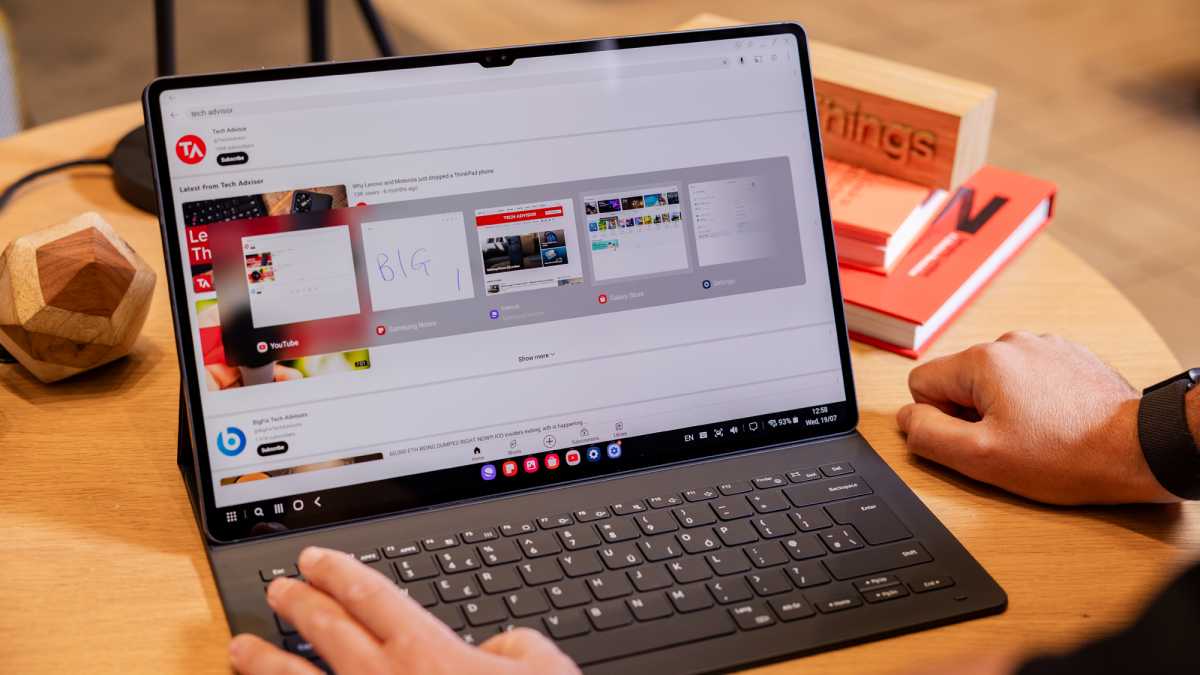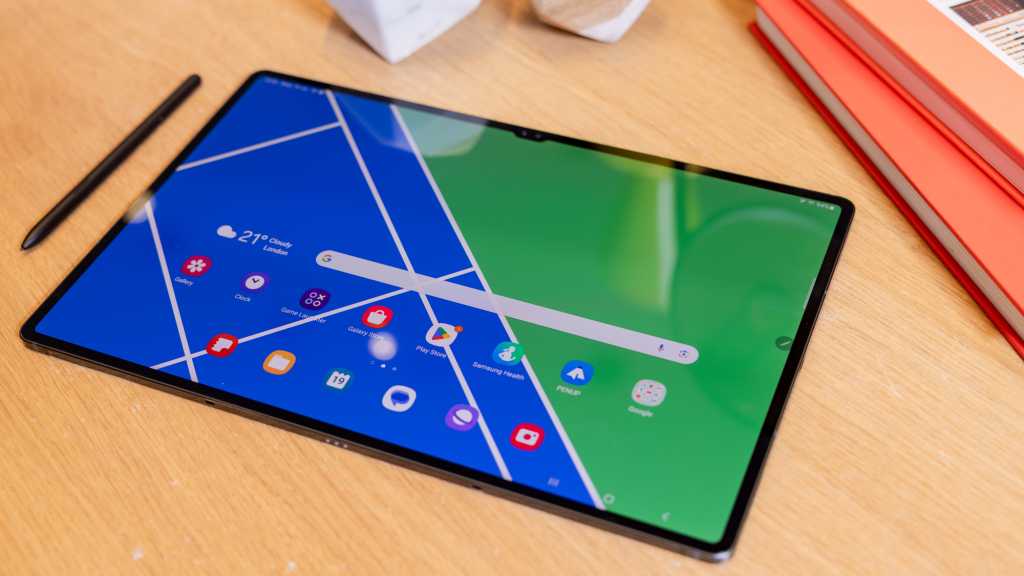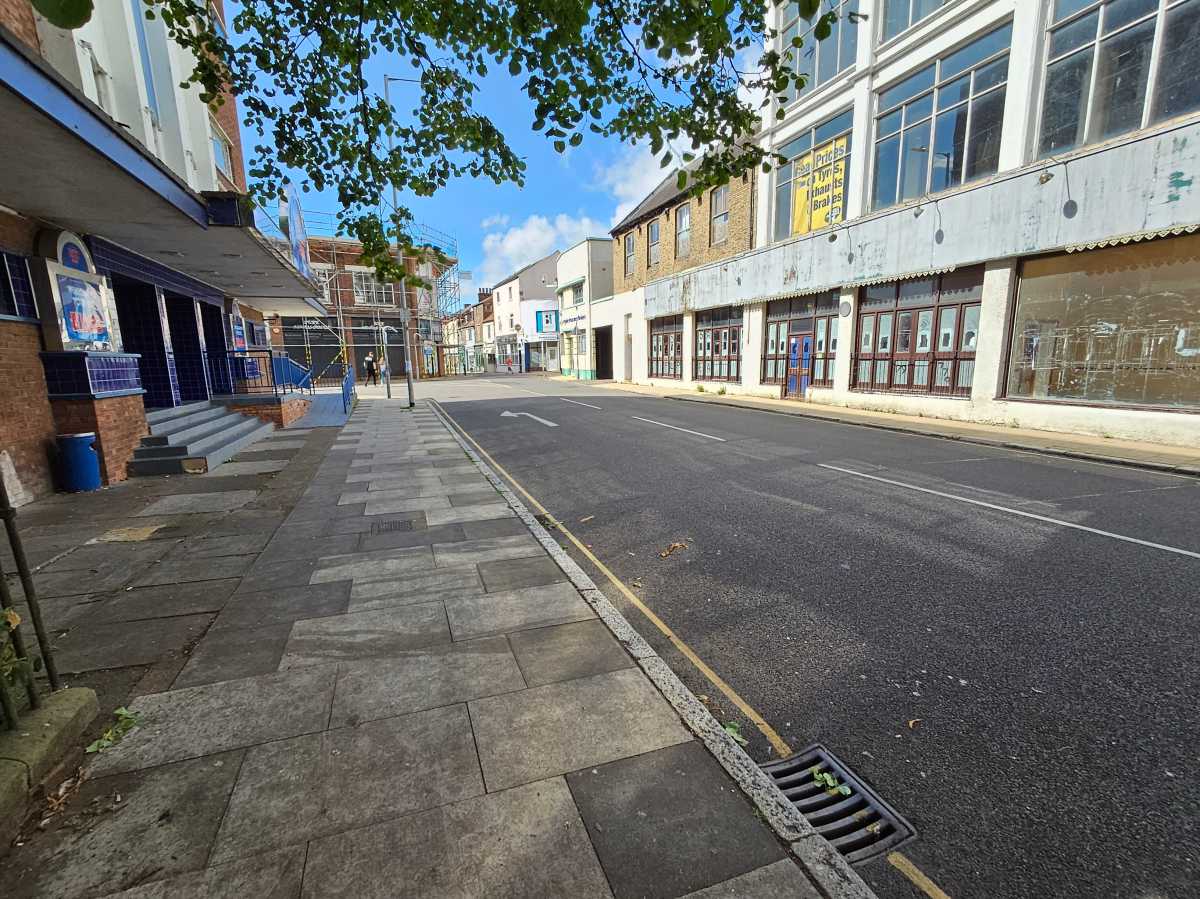Expert's Rating
Pros
- Gorgeous display
- Stellar performance
- Great S Pen experience
- IP68 dust and waterproof
Cons
- Very expensive
- Many Android apps not optimised
- Keyboard and charger sold separately
- No 5G in the US
Our Verdict
From a hardware perspective, the S9 Ultra is an outstanding tablet. But it really needs to replace your laptop at this price, and the limitations of Android prevent that from being realistic for most people.
Best Prices Today: Samsung Galaxy Tab S9 Ultra
When Samsung introduced the Galaxy Tab S8 Ultra in 2022, it turned more than a few heads. The company took the humble Android tablet to a place it’d never been before, with a huge 14.6in display and powerful specs within an incredibly thin and light chassis.
There are some notable improvements on its successor this year, with the processor, speakers and durability all improved for the Galaxy Tab S9 Ultra. But it’s still fundamentally the same device, meaning the same shortcomings remain.
Design & build
- Huge, premium tablet
- Impressively thin and light
- Unnecessary notch
- Now IP68 dust and waterproof
Let’s get one thing out of the way first: the Tab S9 Ultra is huge. It might not be immediately obvious from photos, but a 14.6in display makes it larger than many laptops. Among tablets, it feels significantly bigger than even the 12.9in iPad Pro.
Despite an impressively slim (and consistent) bezel, that makes it a challenge to hold. It feels like you have a giant monitor in your hands – which you do, essentially.
The only difference is that Samsung has managed to cram all the necessary components into a chassis which is just 5.5mm thick – a real feat of engineering.
Samsung has managed to cram all the necessary components into a chassis which is just 5.5mm thick – a real feat of engineering
However, it’s not exactly easy to use. I had to adjust my grip multiple times to reach some content, and it never felt comfortable. Tasks such as browsing the web, scrolling social media and typing were all awkward without a cover or keyboard.
The official Book Cover Keyboard, which introduces the possibility of the S9 Ultra being a laptop replacement, costs an extra $349.99/£339. It also adds 644g onto the initial 732g (737g for 5G) weight, making the device less portable.
I wasn’t able to test this with the S9 Ultra, though it’s unchanged from the S8 Ultra version. You still get a great trackpad and decent typing experience, but it adds a lot of bulk to the device and detaches from the display too easily.

Dominik Tomaszewski / Foundry
Plenty of more affordable accessories are available, including those without a keyboard and trackpad. They’re also all available on the more compact regular Tab S9 (11.4in) and S9 Plus (12.4in), which still have plenty in common with the Ultra.
When it comes to design, not much has changed on the S9 Ultra. It’s still a premium blend of aluminium and glass, with Gorilla Glass 5 helping improve the screen’s durability.
The device now has an IP68 rating, meaning it can survive being up to 1.5m underwater for 30 minutes and is fully protected against dust. That’s a big upgrade over the Tab S8 range, which had no IP rating at all.
Aesthetically, the tablet isn’t anything to write home about. There is now at least a choice of colours (Graphite or Beige), but neither are particularly eye-catching. I personally prefer this minimalist design, though it won’t be for everyone.

Dominik Tomaszewski / Foundry
The design of the dual rear cameras will be familiar to anyone who’s used a Galaxy S23 phone, but the long magnetic strip below might not be. This is used to charge the included S Pen and pair it with the tablet, both of which work seamlessly.
However, this implementation is still far from ideal. The magnets that attach the S Pen are relatively weak, meaning it can easily be dislodged while in a bag or on a table. It also creates an awkward wobble when placed face-up on the table.
You can attach it to some of the sides instead, but the magnets are even weaker here and it won’t charge. While the S Pen is much chunkier than the S23 Ultra phone version, I really wish Samsung had found a way to build it directly into the device.
It’s great to see selfie cameras prioritised, but the S9 Ultra has included a notch to make room for both front-facing sensors. This is totally unnecessary – a slightly thicker bezel would’ve avoided any need for this and looked much better in the process. However, it’s not a dealbreaker.

Dominik Tomaszewski / Foundry
Display, S Pen & audio
- Excellent 14.6in OLED display
- Impressive S Pen stylus
- Above-average speakers
Samsung hasn’t changed the core aspects of the Tab S9 Ultra’s Dynamic AMOLED 2X display, but it didn’t need to: this is one of the very best screens on any mobile device.
It’s a 14.6in, 1848×2960 panel, adopting the boxy 16:10 aspect ratio we now see on many laptops. It’s a great panel for content consumption, though you will have to put up with black bars above and below the action (letterboxing) while watching most movies.
This is one of the very best screens on any mobile device
As an OLED display, you get both deep blacks and rich, vibrant colours. The latter is particularly evident on the default ‘Vivid’ mode, but the more toned-down ‘Natural’ setting is preferable in some situations.
Whichever you choose, that high resolution (between 1440p and 4K) ensures a superb level of detail. Text and images look clear and crisp across all the apps and menus I used, many third-party options, both in light and dark mode. It’s a very versatile display.
During multitasking, the 120Hz refresh rate comes into its own. Using two or more apps side-by-side feels very fluid and responsive, whether you’re scrolling through pages, typing on a document or watching a video. The screen is well-suited for almost every tablet task you can think of.

Dominik Tomaszewski / Foundry
However, it’s not a great choice for outdoor usage. The measured 355 nits of peak brightness (though Samsung quotes 930 nits) is plenty for indoors, but visibility is significantly affected by reflections outside. It’s a better choice for a plane or train.
Within the display is a fingerprint scanner, with Samsung continuing with its ultrasonic sensor rather than the more popular optical version. I found it to be a little temperamental, particularly when switching between landscape and portrait orientation. It unlocks most of the time, but not always on the first try.
While the Tab S9 Ultra’s display is a touchscreen, it also supports stylus input via the included S Pen. A response time of just 2.8ms means there’s no noticeable delay before your note or doodle shows up on screen.
Samsung hasn’t made any changes to its design, so it still looks and functions much like a ballpoint pen. The only real difference is the single physical button on the side, which can be used for a variety of different functions (known as ‘Air actions’) depending on the app you’re using.

Dominik Tomaszewski / Foundry
For me, the only thing missing is that the top of the S Pen doesn’t double as an eraser. But even if you only use the stylus occasionally, it’s a great accessory to have around.
When it comes to audio, the quad stereo speakers certainly add to the experience. They bring a depth and warmth to the sound that you don’t often get on tablets. Expect plenty of volume, and even a nice hit of bass.
Specs & performance
- Superb Snapdragon 8 Gen 2 performance
- Expandable storage up to 1TB
- No 5G in the US
As you might expect, the Tab S9 Ultra delivers top-tier performance. In fact, it’s more powerful than all non-Samsung Android tablets out there.
On the Android side, no tablet can beat the S9 Ultra when it comes to performance
That’s because it uses the Snapdragon 8 Gen 2 for Galaxy chipset, an overclocked version of Qualcomm’s latest and greatest that’s only available Tab S9 tablets and Galaxy S23 phones (at the time of writing). It boosts CPU speeds from 3.2GHz to 3.36GHz and GPU speeds from 680MHz to 719MHz.
Will you notice a difference, even compared to the 8 Gen 1 powering the Tab S8 Ultra? Probably not. But that slight performance boost means the S9 Ultra is even more future-proofed than before. That’s more important on a tablet, where you’ll want to keep it for at least a few years.

Dominik Tomaszewski / Foundry
As for the performance right now, it’s simply superb. Alongside a whopping 16GB of RAM on the model I tested (but still 12GB on cheaper versions), it breezes through almost every conceivable task with ease.
That includes regular tasks such as web browsing, email, social media and watching videos. Even with two or more of these combined in split-screen multitasking, there’s no slowdown whatsoever.
Expect similarly strong performance in mobile gaming, where titles such as Call of Duty: Mobile, PUBG Mobile and Asphalt 9: Legends all run smoothly and lag-free. I don’t believe there’s a single app in the Google Play Store that could push the Tab S9 Ultra close to its performance limits.
On the Android side, no tablet can beat the S9 Ultra when it comes to performance. But even Apple’s M1 iPad Pro from 2021 has a clear upper hand, at least according to the benchmarks.
Samsung Galaxy Tab S9 Ultra benchmarks
The Tab S9 Ultra also introduces a new storage option: 1TB. It’s nice to have, but only necessary if you store lots of files locally or plan to use it as a laptop replacement. Even on 256- and 512GB models, you can use a microSD card to expand it up to 1TB.
Wi-Fi 6E is available on all models, but the situation is more complicated on 5G cellular connectivity. An optional model is available in the UK and Europe, even if you’ll need to pay extra for your own contract. But it’s completely missing in the US, and there’s no 4G as an alternative either.
Cameras & video
- Decent 13Mp main and 8Mp ultrawide rear cameras
- Impressive dual 12Mp front-facing cameras
- Solid microphones
While a tablet should never be your main photography device, the cameras on the S9 Ultra are surprisingly important.

Dominik Tomaszewski / Foundry
There are four lenses in total, equally split between the front and back of the device. A 13Mp main rear sensor is unchanged compared to the S8 Ultra, so it continues to deliver solid but unremarkable shots. Image quality is roughly on par with a mid-range phone, offering a decent level of detail and vibrant colours.
The ultrawide next to it is now 8Mp (up from 6Mp), meaning the drop-off in quality isn’t as noticeable. Dynamic range and exposure both suffer slightly, but it’s a nice alternative when you want to fit more in the frame.
As annoying as the notch is, Samsung has put that space on the front to good use. The regular and ultrawide sensors are both 12Mp, meaning both offer clear and crisp selfies with plenty of detail.
But the front-facing cameras come into their own for video, whether it’s on your own or as part of a group. Both can capture footage at up to 4K 30fps, which is far superior to any built-in laptop webcam.
Alongside three crystal-clear microphones which do a good job of filtering out most background noise, the S9 Ultra is an excellent device for video calling.
The S9 Ultra is an excellent device for video calling
Battery life & charging
- 11,200mAh battery
- Middling battery life
- Slow charging
On paper, the Tab S9 Ultra has a battery that’s plenty big enough. Its 11,200mAh capacity is larger than almost all Android tablets, even if there’s no change compared to the S8 Ultra.
However, the huge display and flagship-level performance place a lot of demands on the battery. Assuming you don’t want to turn on power-saving mode or reduce screen refresh rate, battery life is only average.
If you plan on using the S9 Ultra to get work done, don’t expect a full day of usage on a single charge. With brightness set to a fairly typical 200 nits, I recorded a time of 7 hours and 53 minutes in PCMark’s battery test, which simulates a range of real-world tasks.
I was hoping for better battery life from such an expensive device
It also roughly aligns with my experience, so means you’ll want to stay within reach of a power source as the day comes to an end. If you only plan on using the tablet in the evening, you’ll be able to get two or even three days of usage. But I was hoping for better battery life from such an expensive device.
The S9 Ultra charges via USB-C at up to 45W, but there’s no charger in the box. Using a 65W Samsung laptop charger I had to hand, it reached 13% in 30 minutes and 26% after an hour. But a full charge took over four hours, and there’s no wireless charging.
Software & features
- Android 13
- One UI 5.1
- DeX mode and more
Software is the biggest weakness of the Tab S9 Ultra, but it’s not for the want of trying.
Out of the box, the tablet runs Samsung’s One UI 5.1 skin over Android 13. While designed for smartphones, there are a few tweaks that allow it to run better on the big screen.
Swiping down from anywhere at the top of the screen reveals a larger notification shade, offering full access to quick settings. A dock appears each time you open an app, making it easier to navigate or begin multitasking.
Then there’s DeX mode, Samsung’s optional mode for a desktop-like experience. It works best with a keyboard and trackpad or mouse, but still responds to touch. You can use it directly on the S9 Ultra, or connect (wirelessly or via a cable) to an external monitor or your TV.

Dominik Tomaszewski / Foundry
DeX feels much more like a laptop than the regular tablet interface, and it runs all Samsung and Google apps very smoothly. But third-party options are much more hit-and-miss, with many simply larger versions of the smartphone app. Some apps refuse to open at all in DeX mode.
Compared to a Windows or macOS laptop, DeX doesn’t utilise the space available nearly as well, so things can quickly become cluttered. It’s a useful option if you’re happy with web browsing and basic mobile apps, but that won’t apply to many people.
Software is the biggest weakness of the Tab S9 Ultra, but it’s not for the want of trying
As a pure tablet, the S9 Ultra is much more impressive. Its multitasking features are excellent, while optimised apps are a joy to use. Dedicated tablet apps simply aren’t a priority for many third-party developers, but Samsung is making the most of the software available to it.
The company is also generous with software updates. You’ll get four major new versions of Android, taking you up to a potential Android 17. Security updates will then continue until 2028.
Price & availability
Regardless of the model you choose, the Tab S9 Ultra is expensive.
For a Wi-Fi version, prices range from $1,199/£1,199 to $1,619.99/£1,549. The top-spec 5G model I tested costs £1,699, but there’s no option for 5G in the US.
You can buy the tablet from a range of retailers, including Samsung and Best Buy in the US and Samsung and Amazon in the UK.
While the S Pen stylus is included in the cost, you’ll need to purchase a cover separately. The full version with a keyboard and trackpad costs $349.99/£339.
That’s more expensive than any other Android tablet you can buy. The 12.9 iPad Pro (from $1,099/£1,249) is its main rival, but Windows devices such as the Intel-powered Surface Pro 9 (from $999/£1,099) are also worth considering.
Before buying the Tab S9 Ultra, it’s worth making sure that a regular laptop or 2-in-1 wouldn’t suit you better.
Verdict
The Tab S9 Ultra is a tablet on steroids, blowing all other Android slates out of the water..
This 14.6in behemoth feels almost impossibly thin and light, especially considering the top-tier performance and sizeable battery housed within.
Its display is simply superb, when it’s plenty powerful enough to run any Android app you can think of.
But therein lies the problem. Despite some tablet-specific tweaks and DeX mode, the lack of dedicated tablet apps and desktop-level software still holds it back.
And at this price, being a great content consumption device simply isn’t enough for most people. Unless you can see yourself using the S9 Ultra instead of a laptop, there are better options elsewhere.
Specs
- Qualcomm Snapdragon 8 Gen 2 (overclocked)
- 12/16GB RAM
- 256GB/512GB/1TB storage (expandable via microSD)
- 14.6in 120Hz AMOLED display (1848×2960)
- Dual rear cameras: wide (13Mp, f/2.0) and ultrawide (8Mp, f/2.2)
- Dual front-facing cameras: wide (12Mp, f/2.2) and ultrawide (12Mp, f/2.4)
- Quad stereo speakers
- IP68
- Wi-Fi 6E
- Bluetooth 5.3
- 5G (optional, not in US)
- S Pen stylus (included)
- 11200mAh battery
- 45W wired charging
- Android 13 with One UI 5.1
- 326.4 x 208.6 x 5.5 mm
- 732g (Wi-Fi) or 737g (5G)












